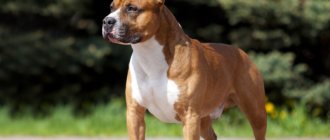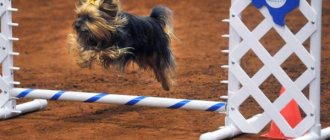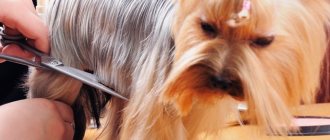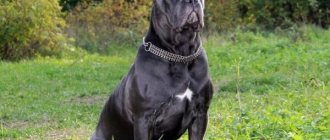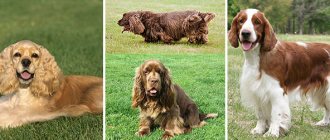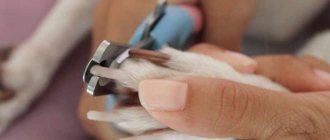Cupping is a controversial operation. As a rule, it is purely aesthetic in nature. According to long-time fans of the breed, cropped ears and tails improve the exterior and make the Boxer more formidable.
Initially, fighting boxers had their ears and tail docked. Very rarely, surgery is performed for medical reasons. In all other cases, it’s just a tribute to tradition.
Why is cupping necessary?
As a rule, the need for tail docking is explained by the fact that a boxer can break it during intense physical exertion. This is a rather controversial proposition.
Other breeds do not break uncut tails as often. This possibility exists when the dog participates in battles or fights with wild animals. The same applies to the ears.
It is mandatory to crop a boxer's ears if the owner plans to exhibit the animal in fights. It is in this part of the body that many nerve endings are concentrated.
Such an operation can also be regulated by purely medical considerations. Cropping of the auricle is provided if the animal has diseases:
- necrosis;
- external ulcers;
- various injuries;
- oncology.
This is interesting! It is believed that dogs with drooping ears are more susceptible to otitis media and other diseases of the ear canal. But diseases can be avoided if you regularly clean your pet's ears.
Often, many people get Boxers simply because they like the look of the breed. The dog becomes a pet and does not participate in dog fights. But the owners still take the puppy for trimming, since the appearance of cropped ears and tail is more familiar to them.
Pros and cons
Opponents of docking call for abandoning the procedure, as it is inhumane to the animal. In addition, surgery carries certain risks. Whether a pet should be endangered, especially in the absence of medical indications, is up to the owner to decide.
Proponents of the procedure talk about a more aesthetic appearance of the dog. Those who put the animal up for fighting see docking as having a purely practical meaning.
Before deciding to trim, you should consult your veterinarian to evaluate your Boxer's health. We need to think about the purpose for which the animal was bred. And it's not just about dog fighting.
If the owner plans to participate in foreign exhibitions, it is worth considering that in Belgium, Germany and Switzerland there is a ban on docking. Therefore, a dog with cropped ears and tail will not be allowed to participate.
Is it possible to leave a Boxer's ears and tail undocked?
The Russian standard does not stipulate that this procedure is mandatory for representatives of the breed. In Europe they are gradually coming to the conclusion that the animal should remain in its natural form.
In the CIS countries they look at this more conservatively.
Important! The ears and tail are the means of communication in dogs. A dog deprived of these body parts has fewer opportunities to show his mood to his fellow breeder. And this can lead to undesirable consequences. For example, to a fight.
Pros and cons
Contrary to popular misconceptions, docking or its absence does not in any way affect the health of the dog. Frequent ear diseases in undocked dogs, bloody tails of Dobermans, photographs of which circulate on the Internet, are nothing more than a myth. “An undocked dog will perfectly learn to use its own tail, and will injure it no more often than cats or ordinary tailed dogs,” Arseny Gelasimov is sure. — And inflammatory diseases of the ears in an undocked boxer will not occur more often than in a docked one. It should be noted that dogs such as cocker spaniels and basset hounds, known for their problematic ears, do not have them cut off.”
For the service qualities of a dog, the tail and ears also do not play any role - unless, of course, it is used for hunting or dog fighting (which are prohibited in Russia and many countries of the world). And some dog breeders even argue that docking harms the animal’s working qualities: “It makes service dogs inferior,” says Doberman owner Evgeniy Ordin. “After all, in nature everything is functional: the tail, for example, is needed to control the body in a jump.”
One of the most compelling arguments against docking is that the dog needs the tail and ears to express emotions. “The tail and ears help the dog convey a variety of emotions: alertness, anger, fear,” comments Arseny Gelasimov. “Therefore, the presence of a tail is important for dogs’ communication and adaptation in a group.”
Of course, the arguments “for” and “against” can be given endlessly, but one thing is clear - the dog itself does not need docking. Whether it is worth subjecting your pet to even a simple operation just to meet human ideas of beauty, each owner decides for himself. Be that as it may, for people who don't care so much whether her tail is long or short - the main thing is that she is healthy and happy. But for those who dream of a show career for their dog, everything is much more complicated.
Preparing a boxer for docking
Before surgery it is important:
- clean the ears well, examine them for inflammation;
- buy medications recommended by a veterinarian;
- Do not feed the puppy 12 hours before the procedure.
Surgery should be postponed when the puppy exhibits the following conditions:
- pus is discharged from the ears;
- the pet does not eat;
- the dog has swelling in different parts of the body;
- the puppy is developmentally delayed;
- increased body temperature;
- there are other signs of illness.
History of the origin of the German Boxer breed
The ancestors of the German boxer are Bullenbeissers, which means “bullmen”. They were common in Europe already in the 6th-7th centuries. and were used to hunt forest animals. Fearlessness, endurance, agility, remarkable strength and powerful jaws made them a threat to bears, wild boars, wolves, and bison. By the end of the 17th century, when forest lands began to shrink due to the spread of agriculture, Bullenbeisers mastered the profession of security guards.
The first attempts to develop a new breed began in Munich at the end of the 19th century. It was then that the Bullenbeiser was crossed with the English Bulldog. A significant contribution to the development of the breed was made by dog handler and trainer Friedrich Robert. With a team of like-minded people, he began to make the dream of an elegant, powerful, fit and balanced service dog a reality. The fruit of joint labors - the first boxer Flocky - was presented at the exhibition in 1895.
In 1825, the Russian artist Bryullov depicted Princess Golitsyna in the company of a bullenbeiser
Subsequently, Mrs. Shtokman, the owner of the Von Dom kennel, founded in 1911, played a major role in the development of the breed. All her life she carried out breeding work and became the “mother” of many outstanding sires and champions. For example, her boxer Rolf, a multiple winner of various exhibitions, was called up for military service, from where he returned unharmed and triumphantly completed his exhibition career at the age of 11.
By the middle of the 20th century, German boxers became so popular that the need arose to create an International Association of Fans of the Breed (ATIBOX). It coordinates its further development and unites 25 countries. Today, the German boxer is recognized by all leading cynological associations (CKC, FCI, AKC, UKC, ANKC, NKC, NZKC, APRI, ACR).
In 1925, German boxers received the status of service police dogs, and in wartime they were postmen, scouts, guards and messengers
How to dock the tail
There are two ways to dock a Boxer's tail:
- If the operation is performed at the age of 3–10 days, then anesthesia is not administered. At this time, ossification of the vertebrae has not yet occurred and sensitivity is much lower. For older puppies, anesthesia is indicated. The hair is shaved from the tail, the skin is pulled back to the base, and an incision is made between the vertebrae. Next, the skin is pulled over the stump and a suture is applied. The wound is treated with antibiotics and antiseptics. The final step is a sterile dressing.
- Another method is to squeeze it with an elastic band for a week. Its essence is that the applied tourniquet prevents the flow of blood, and part of the tail simply dies. Some experts consider it more humane than surgical intervention. Others do not agree with them, since it is difficult to imagine what the pet feels at this time. However, after amputation, puppies in 100 percent of cases whine for about 20 minutes and only then calm down. The owner should consider whether it is necessary to subject the pet to such a procedure.
Boxers, according to old standards, are left with a tail 19 mm long.
German boxer health
Despite their robust appearance, German boxers live for about 10–12 years. Common problems include:
- Hip dysplasia is a pathology in which the shape of the femoral head and the acetabulum (the depression in the pelvic bone) do not correspond to each other. Osteoarthritis may subsequently develop. Symptoms of the pathology are lameness, difficulty in climbing, jumping, and passivity of the animal. An x-ray will help identify it. Treatment involves taking vitamin and mineral complexes, weight control, and swimming. In extreme cases, hip replacement surgery is performed.
- Brachycephalic syndrome caused by the structure of the muzzle. Because of this, boxers are prone to colds and overheating, snore, and experience shortness of breath during physical exertion and stress. The result can be pulmonary edema and heart failure. For preventive purposes, veterinarians perform operations to widen the nostrils and plastic surgery of the soft palate.
- Aortic stenosis is a heart defect that leads to thickening of the myocardium, oxygen starvation and heart failure. Developmental delays, exercise intolerance, cyanosis of the mucous membranes, shortness of breath and fainting should cause concern. Heart ultrasound can help diagnose the disease. Treatment involves taking medications, limiting physical activity, and in severe cases, surgery.
- Entropion and ectropion. In the first case, the eyelid with eyelashes growing on it comes into contact with the cornea, causing irritation. The dog rubs its eyes with its paws and squints. In the second case, the eyelid droops excessively, forming a pocket. This can cause the cornea to dry out and can lead to blindness. Both pathologies are treated with medication and surgery.
To ensure a long and active life for your German Boxer, take care of a balanced diet, exercise and regular veterinary examinations.
How to crop ears
The operation takes 20 minutes and takes place in several stages:
The shape of a Boxer's cropped ears can be of two types: square or “devil-like” (high, pointed ears, similar to horns).
Appearance and breed standard
The German Boxer is a dog of medium height, stocky, with developed lean muscles, prominently protruding under short hair. All the dog's movements are noble, proud and demonstrating his strength. The height of the dog is from 53 to 64 centimeters, the weight of the German boxer is from 25 to 32 kilograms.
The breed has the following standards:
- The head is square in shape. The transition from the muzzle to the forehead is sharp. The muzzle is voluminous and wide.
- The jaws are strong. The lower one protrudes and gives the muzzle a threatening appearance.
- The nose is black, upturned and raised, slightly flattened.
- The ears are set high, and after cropping they acquire sharp outlines.
- The eyes are dark brown. Eyelids with black pigmentation.
- The neck is shaped like an elegant arch, rounded, muscular, dry. The transition to the withers is clearly expressed.
- The body is square-shaped, lean, with prominent muscles protruding under the skin. The back is short and straight. The lower back is strong.
- The croup is sloping, rounded, wide.
- The chest is deep, up to the elbows. The ribs are curved.
- The tail is set high. Docked short.
- The limbs are parallel to each other. The shoulder blades are long and oblique. Elbows slightly pressed to the chest. Hind limbs with clearly defined muscles. Knees are forward. The paws are rounded and collected.
Disadvantages of the breed:
- Fangs protruding from the surface of the muzzle.
- Short, thick neck.
- Narrow or hunchbacked back.
- Weak muscles of the limbs.
- Falling paws.
- Wandering movements, stilted gait.
Coat type and colors
The coat of German Boxers is short, close to the body, and shiny. The structure of the guard hair is hard.
Boxers can be white, but such dogs are rare, and this color option is not included in the standard.
The main colors provided for by the breed:
- Brindle.
- Red (fawn) with any shade from light to mahogany.
Both colors require a black mask and black ears. White markings up to 30% of the color are allowed, located on the paws, belly, and chest. White color on the back and sides, as well as on the muzzle, is not allowed.
The white German boxer is considered very rare. Due to its rarity, this color is considered to bring good luck to its owners. However, the world breed standard does not allow this color.
Care after cupping
After surgery, you do not need to change anything in your diet. If the baby is still feeding on mother's milk, it is brought to the female only for feeding. This is due to the fact that the mother may begin to lick the stitches, which will complicate the healing process. If the puppy does not want to eat, there is no need to force him. This may be a temporary reaction after anesthesia or stress.
The main thing is to prevent infection. To do this, it is necessary to regularly change the bedding and treat the seams with an antiseptic daily (2 times a day). Greenery or peroxide will do.
To prevent your pet from scratching the stitches, wear a special collar. Its wearing is indicated until complete healing.
Choosing a German Boxer Puppy
When choosing a four-legged friend, pay attention to:
- reputation of the nursery;
- pedigree and titles of parents, their compliance with the standard;
- appearance and behavior of the puppy - it must be active, friendly, sociable, well-fed, with healthy teeth, fur, clean eyes and ears;
- availability of a full package of documents (metrics, veterinary passport with vaccination and deworming marks, purchase and sale agreement).
Prices for German Boxer puppies depend on the class:
- companion animals cost from 5 thousand rubles;
- babies for breeding - from 15 thousand rubles;
- future champions - from 30 thousand rubles.
Red puppies are cheaper than their brindle counterparts
Cost of cupping
The cost of the operation varies depending on the age and condition of the dog. Below are the prices for holding it in Moscow.
Boxer ear cropping
AgeCost, rub.
| up to 10 days (local anesthesia) | 2 000 |
| from 10 days to 3 months | 4 000 |
| over 3 months | 6 000 |
Boxer tail docking
AgeCost, rub.
| up to 10 days (local anesthesia) | 500 |
| from 10 days to 2 months | 1 000 |
| over 2 months | 1 500 |
The fashion for cropped ears and tails is gradually passing
Veterinarians say both procedures—tail docking and especially ear cropping—are becoming increasingly rare.
“I’ve worked with almost 40 veterinarians in my career and know maybe two who do crops,” Roark says.
Banfield Pet Hospital, the largest pet hospital chain in the United States, no longer performs tail and ear docking. And the AKC says dogs without tail and ear docking are just as likely to win in shows.
Fifteen of the 225 dogs that competed in the agility competition at the 2014 Westminster Kennel Club show were multi-breed (also called "all-American"). “We're seeing a lot more dogs with natural ears in the show ring,” says Westminster spokesman David Frey.
Owner reviews of the German boxer
Natalie
An excellent breed, but it requires a lot of attention, especially at a young age. Destroys the apartment if left unattended. He is very kind, loves everyone, but his neighbors are afraid of him. It seems to me that there is not enough space for him in the apartment. In general, the breed is not for everybody.
Tata
Anyone who has ever owned a Boxer will never be able to fall in love with the breed! A devoted friend, a reliable comrade, he became happiness for us! This dog has a soul. It's a pity that they don't live long.
Stas
I picked this one up outside in the cold. I was afraid to take two small children home. But he brought me anyway. Bucks behaved well, immediately fell in love with the children - he does not leave them, he still lives with us, he is already an old man. If you want a boxer, get one and don’t hesitate.
Ilya
The dog is lively and playful. I also train during games. He loves to follow the “Crawl” command when I put several chairs in a row and call him from the opposite side. He doesn’t learn the “Fu” command well, I’ve been struggling for two months now.
Nika
I have never regretted buying a German boxer for my son. Easy to care for, perfectly obedient and cheerful, the dog became the favorite of the whole family from the first days. Nothing spoils anything in the house. He calmly waits for his son to come home from school and take a walk with him. One minus - he climbs into bed all the time, we can’t teach him to sleep on his bed.
Victor
My boxer named Chelsea is sociable and friendly to everyone. He enjoys playing ball with the kids in the yard and loves the “fetch” command. He learned commands very quickly, but is not always in a hurry to carry them out, he is cunning. You need to be able to negotiate with this dog. Can't stand drunk people, literally rushes at them.
Video
Maintenance, care and nutrition
This breed of dog is absolutely not suitable for street keeping; its representatives must live in an apartment or house with people.
The German boxer does not tolerate both heat and cold. Extended exposure to the direct sun can cause the animal to suffer from heatstroke. In frosty or damp weather, your pet may catch a cold. In the autumn-winter period, you need to walk your dog in special overalls. If the apartment is cool, you may need “lounge” clothes.
The lounger should be placed away from drafts and heating radiators. The bedding should be soft and spacious so that the dog has the opportunity to stretch out. The place is selected in such a way that the pet can look around the entire room without leaving it - this way he will feel calm.
